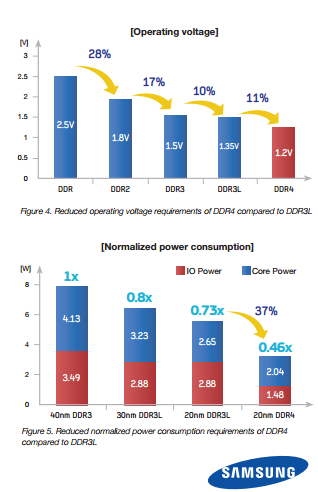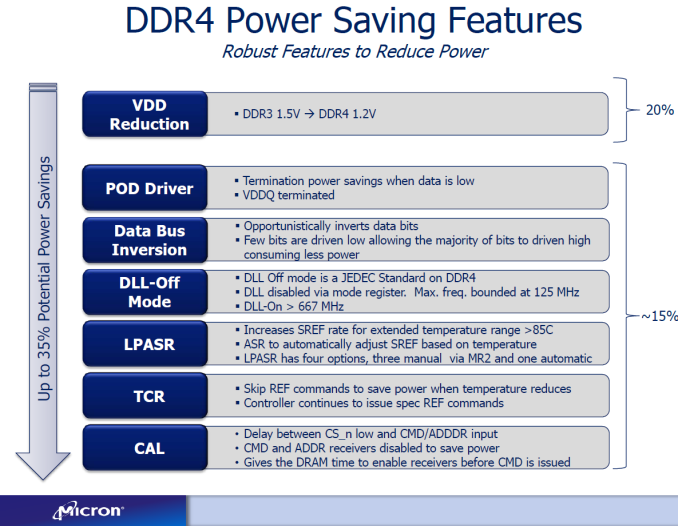Intel Xeon E5 Version 3: Up to 18 Haswell EP Cores
by Johan De Gelas on September 8, 2014 12:30 PM ESTDDR4
Intel and the DRAM world are switching over to DDR4 and with good reason. DDR4 is a large step forward, and some of the highlights of DDR4 include the following:
- Speeds up to 3200 MT/s (1.6GHz Double Data Rate)
- Lower DRAM I/O voltage (1.2 instead of 1.5 V VDDQ)
- Twice the capacity (using the same DRAM chips)
- Improved RAS
The improvements start with the internal organization. A DDR3 chip has eight independent banks, while DDR4 comes with 16 banks, organized in a 4x4 configuration: four bank groups with four banks. More banks mean that more pages can stay open (more page hits, lower latency) at a small power increase, which is completely negated by a whole range of power efficiency features (see further). The power efficiency gains are rather large. Samsung quantifies them in the slide below.
Samsung claims about 21% lower power thanks to the drop in operating voltage (1.5 ->1.2v). Low Power DDR4 will run at 1.05v and will lower the power usage even further. But there is more to DDR4 than lowering the voltage. Samsung claims that, when both are manufactured with the same process technology, the DDR4 runs at 2/3 of the power DDR3L needs.
Micron gives a break down of the features that made DDR4 more power efficient besides the obvious drop in VDDQ.
Note that the total power efficiency increase is 30-35%, and this is not just a result of the VDD reduction (20%). In that sense, DDR4 is a larger step forward than previous DDR technology transistions. Of course, the 30-35% improvement in power efficiency is measured with RAM running at the same speed. It's also possible to run DDR4 at much higher speeds (3200 MT/s vs 1866 MT/s) while sacrificing some of the power savings. The DDR4 memory that we are using for testings runs at 2100 MT/s, a good compromise between a mild speed increase and power efficiency.
A more elaborate discussion will follow in our next server memory article, but each bank also has much smaller rows (four times smaller) and thus the cycle time of the DRAM can be much higher. The result is lower latency.
The improved signal to noise ratio and the extra pins for addressing allow DDR4 to support eight DRAM stacks instead of four (DDR3). As a result, DDR4 can support twice the capacity of DDR3 using the same (4-16Gb) DRAM chips. This will require the use of 3D stacking technology, which will take time to implement. However, since 8Gb chips are now used, Registered DIMMs of 32GB should soon be a reality, as well as 64GB LRDIMMs. We'll discuss this in more detail on the next page.












85 Comments
View All Comments
MorinMoss - Friday, August 9, 2019 - link
Hello from 2019.AMD has a LOT of ground to make up but it's a new world and a new race
https://www.anandtech.com/show/14605/the-and-ryzen...
Kevin G - Monday, September 8, 2014 - link
As an owner of a dual Opteron 6376 system, I shudder at how far behind that platform is. Then I look down and see that I have both of my kidneys as I didn't need to sell one for a pair of Xeons so I don't feel so bad. For the price of one E5-2660v3 I was able to pick up two Opteron 6376's.wallysb01 - Monday, September 8, 2014 - link
But the rest of the system cost is about the same. So you get 1/2 the performance for a 10% discount. YEPPY!Kevin G - Monday, September 8, 2014 - link
Nope. Build price after all the upgrades over the course of two years is some where around $3600 USD. The two Opterons accounted for a bit more than a third of that price. Not bad for 32 cores and 128 GB of memory. Even with Haswell-E being twice as fast, I'd have to spend nearly twice as much (CPU's cost twice as much as does DDR4 compared to when I bought my DDR3 memory). To put it into prespective, a single Xeon E5 2999v3 might be faster than my build but I was able to build an entire system for less than the price Intel's flagship server CPU.I will say something odd - component prices have increased since I purchased parts. RAM prices have gone up by 50% and the motherboard I use has seemingly increased in price by $100 due to scarcity. Enthusiast video card prices have also gotten crazy over the past couple of years so a high end video card is $100 more for top of the line in the consumer space.
wallysb01 - Tuesday, September 9, 2014 - link
Going to the E5 2699 isn’t needed. A pair of 2660 v3s is probably going to be nearly 2x as fast the 6376, especially for floating point where your 32 cores are more like 16 cores or for jobs that can’t use very many threads. True a pair of 2660s will be twice as expensive. On a total system it would add about $1.5K. We’ll have to wait for the workstation slanted view, but for an extra $1.5K, you’d probably have a workstation that’s much better at most tasks.Kevin G - Friday, September 12, 2014 - link
Actually if you're aiming to double the performance of a dual Opteron 6376, two E5-2695v3's look to be a good pick for that target according to this review. A pair of those will set you pack $4848 which is more than what my complete system build cost.Processors are only one component. So while a dual Xeon E5-2695v3 system would be twice as fast, total system cost is also approaching double due to memory and motherboard pricing differences.
Kahenraz - Monday, September 8, 2014 - link
I'm running a 6376 server as well and, although I too yearn for improved single-threaded performance, I could actually afford to own this one. As delicious as these Intel processors are, they are not priced for us mere mortals.From a price/performance standpoint, I would still build another Opteron server unless I knew that single-threaded performance was critical.
JDG1980 - Tuesday, September 9, 2014 - link
The E5-2630 v3 is cheaper than the Opteron 6376 and I would be very surprised if it didn't offer better performance.Kahenraz - Tuesday, September 9, 2014 - link
6376s can be had very cheaply on the second-hand market, especially bundled with a motherboard. Additionally, the E5-2630 v3 requires both a premium on the board and DDR4 memory.I'd wager you could still build an Opteron 6376 system for half or less.
Kevin G - Tuesday, September 9, 2014 - link
It'd only be fair to go with the second hand market for the E5-2630v3's but being new means they don't exist. :)Still going by new prices, an Opteron 6376 will be cheaper but roughly 33% from what I can tell. You're correct that the new Xeon's have a premium pricing on motherboards and DDR4 memory.